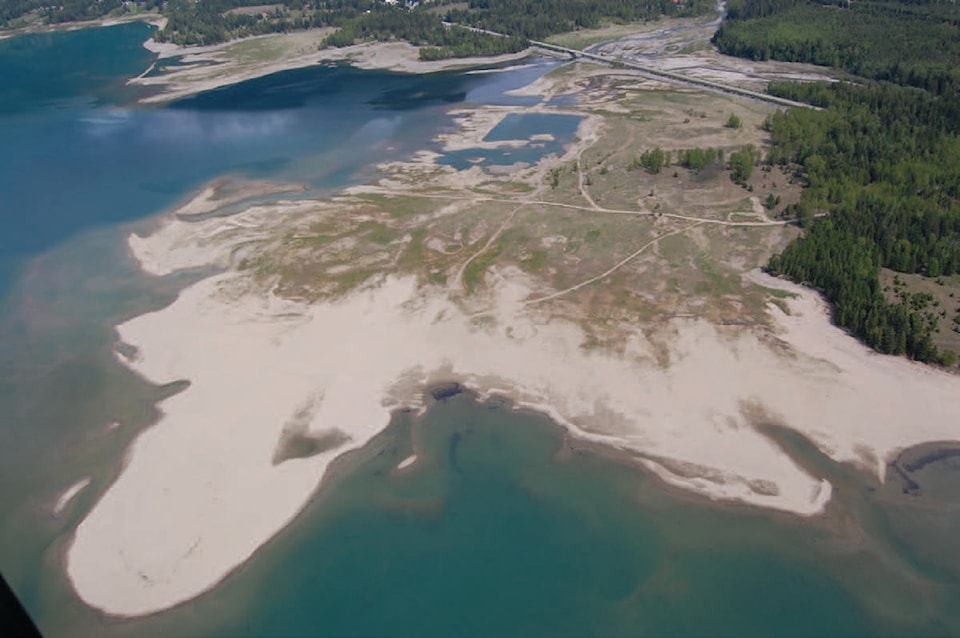-By John Boivin, Local Journalism Initiative Reporter
Officials say a project to improve wildlife habitat on the lower Arrow Lakes is already seeing some modest results.
Bird life was spotted settling into the Burton Flats Wildlife Enhancement Project area this summer.
“We found a spotted sandpiper nesting on top of one of the mounds, one of the newly created features,” Harry van Oort said at an online meeting about the project earlier this month. “It’s an adaptive species that can survive well in the reservoir environment in response to changing conditions.
“It’s a bit of a pioneering species if you will.”
The common shorebird is only the first inhabitant of what project planners hope will be a productive, biodiverse patch of land for birds, amphibians, larger mammals, and the things they eat.
Construction started last year on the project south of Nakusp, which is intended to try to restore some small part of the wildlife habitat lost in the area when BC Hydro built dams on the Columbia River. The damming of the river flooded hundreds of kilometres of Arrow Lakes shoreline. The new shoreline also suffers from periodic flooding when the controlled water levels rise and fall.
The site isn’t much to look at – a 3.5-hectare patch of low-lying land bordered by Highway 6 South near Burton. Last year work began on creating what will ultimately be 10 shallow ponds and low-lying mounds to try to recreate a natural wetland ecosystem.
“Our proximate goal was to provide a much more diverse and structurally complex natural vegetation mix to provide food and nesting habitat for birds and other wildlife,” said van Oort, who is the senior environmental co-ordinator. “The ultimate goal of course is to attract a diverse and productive wildlife community.”
What nature does on its own, humans have had to work hard to re-create. As the ponds and mounds were established, work simultaneously began planting more than 9,000 plants in the area – from plants like bluejoint reedgrass, water sedge, water smartweed and marsh cinquefoil, to woody species like prickly rose, hardhack, soopalallie, mountain alder, and paper birch.
Work had to be done keeping an eye on lake water levels, which could flood work areas quickly.
“It was a herculean effort to plant the 9,000-plus plants,” says van Oort, noting much of that work was done by locally hired workers. “It is physically demanding, a daily endurance test for the crews. They worked extremely long days.”
A lot of the species planted are an experiment to see which ones survive periodic flooding by the lake. As the project designers see which plants thrive best, they’ll plant more of those successful species.
The landscape is also being designed so birds won’t be attracted to building nests in low-lying areas. This will prevent egg loss when the lake levels rise.
Human interference
However, the biggest danger facing the newly created wildlife site may not be flooding, but rather humans recreating at the site.
“During the drawdown in September and October, it’s a very popular area for people to drive their vehicles in, letting their dogs run and stuff,” said Paul Peterson, the Regional District of Central Kootenay director for the region. “There’s pretty good access for vehicles, and there’s people camping there too.
“Is there any way Hydro can stop traffic from going in?”
Officials admitted there was little they could do about that, as the area was a patchwork of Hydro land, Crown land, and private property. They said there was nothing they could do to physically block access to the sensitive ecosystem.
“At this stage it doesn’t look like we’ve done a lot with vegetation, but these species we planted should turn into a canopy from ground level to 30 metres high,” said van Oort. “All those species will create a barrier for wildlife, a visual barrier… and hopefully a deterrent from traffic from motorized vehicles.”
With phase one completed and monitoring underway, work on planning phase two has started. Among the works for next year are two larger, deeper ponds constructed closer to Arrow Lake, as well as expansion of one mound and creation of a second.
“The construction schedule depends on a number of factors, including reservoir levels,” says Trish Joyce, who spoke on the construction aspects of the project. “A spring construction schedule allows us to access the lower features… in particular [two ponds which] are at the lower level and they would be best addressed under spring construction.”
Hydro will have spent about $4.37 million on the habitat by the time the project is complete.
